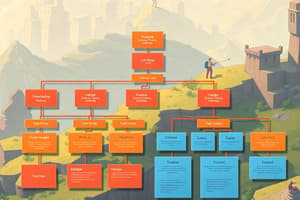Podcast
Questions and Answers
What is one advantage of a well-defined hierarchical structure?
What is one advantage of a well-defined hierarchical structure?
- Limited information flow
- Improved accountability and performance (correct)
- Slow decision-making
- Lack of employee empowerment
Which challenge is associated with hierarchical structures?
Which challenge is associated with hierarchical structures?
- Matrix structures
- Network structures
- Slow decision-making (correct)
- Flat organizational structures
How do flat organizational structures differ from hierarchical structures?
How do flat organizational structures differ from hierarchical structures?
- Flat structures limit employee empowerment
- Flat structures have more tiers between employees and senior management
- Flat structures involve multiple project-based organizational structures
- Flat structures emphasize horizontal connections among employees (correct)
What is a key feature of network structures in organizations?
What is a key feature of network structures in organizations?
Which adaptation allows employees to work on multiple projects simultaneously?
Which adaptation allows employees to work on multiple projects simultaneously?
Why can hierarchical structures limit employee empowerment?
Why can hierarchical structures limit employee empowerment?
What does a hierarchical organizational structure focus on?
What does a hierarchical organizational structure focus on?
How is power and authority delineated in a hierarchical structure?
How is power and authority delineated in a hierarchical structure?
What is one of the advantages of a hierarchical structure with regards to decision-making?
What is one of the advantages of a hierarchical structure with regards to decision-making?
How is expertise developed within a hierarchical structure?
How is expertise developed within a hierarchical structure?
What does each level in a hierarchical structure represent?
What does each level in a hierarchical structure represent?
How does a hierarchical structure contribute to efficiency?
How does a hierarchical structure contribute to efficiency?
Flashcards are hidden until you start studying
Study Notes
Organizational Structure: Focus on Hierarchical Structures
A company's organization structure refers to the arrangement of roles, responsibilities, and relationships among its employees, departments, and divisions, aiming to facilitate efficient communication and goal achievement. One of the most common forms of organization structure is the hierarchical structure, which centers around a clear chain of command and a tiered system of authority.
The Basics of Hierarchical Structure
In a hierarchical structure, there's a clear delineation of power and authority, with employees reporting to superiors who manage and direct their activities. This structure is often represented in an organizational chart, where each level is called a tier or level, and each individual is assigned a specific rank, such as manager, vice president, or CEO (Chief Executive Officer).
Advantages of Hierarchical Structure
Hierarchical structures offer several advantages, including:
- Efficiency: They facilitate the streamlined flow of power and decision-making from the top to the bottom, creating a clear chain of command and a centralized decision-making process.
- Specialization: Hierarchies allow for the division of labor, specialization, and the development of expertise within specific roles and departments.
- Clear roles and responsibilities: A well-defined hierarchical structure leads to a clear understanding of roles and responsibilities, which in turn improves accountability and performance.
Disadvantages of Hierarchical Structure
However, hierarchical structures also present some disadvantages or challenges, including:
- Slow decision-making: Hierarchies can result in a slow decision-making process, as decisions must move through multiple layers of authority before reaching the implementation stage.
- Limited information flow: In hierarchies, information often flows only through channels established by the organizational chart, potentially resulting in limited feedback and reduced innovation.
- Lack of employee empowerment: Hierarchical structures can limit employee empowerment and autonomy, as decisions are often made by higher-level managers.
Adaptations of Hierarchical Structure
To address the challenges of hierarchical structures, some organizations have implemented modifications or adaptations, such as:
- Flat organizational structures: In flat structures, there are fewer tiers or levels, reducing the number of layers between employees and senior management.
- Network structures: Network structures emphasize horizontal connections among employees, making it easier for information and ideas to flow laterally.
- Matrix structures: Matrix structures combine both functional and project-based organizational structures, allowing employees to work on multiple projects simultaneously.
Conclusion
Hierarchical structures are a common and effective way to organize companies, but they also have limitations. By understanding the advantages and disadvantages of hierarchical structures, organizations can make informed decisions about how best to adapt and modify their organizational structures, ultimately improving efficiency, enhancing employee empowerment, and promoting innovation.
Studying That Suits You
Use AI to generate personalized quizzes and flashcards to suit your learning preferences.



